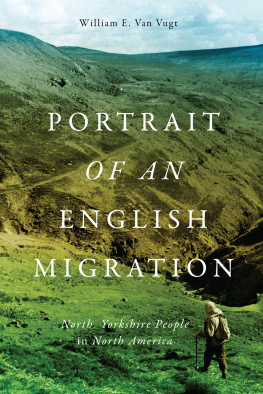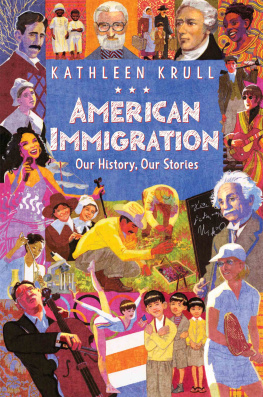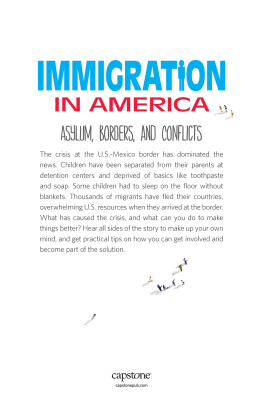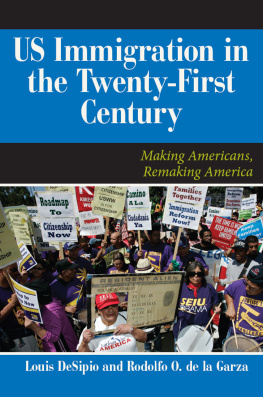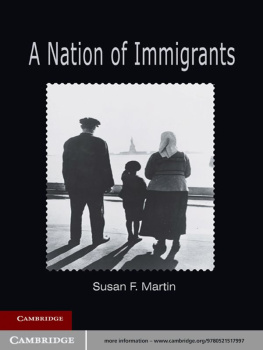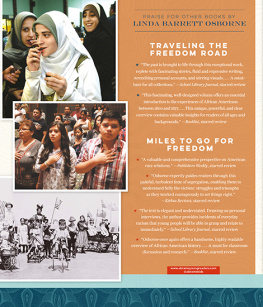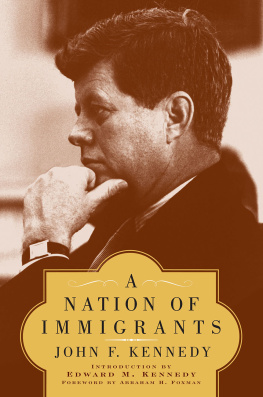BRITISH IMMIGRATION TO THE UNITED STATES 17761914
CONTENTS OF THE EDITION
VOLUME 1
General Introduction
Building a Nation: 17761828
VOLUME 2
The Age of Jackson: 182947
VOLUME 3
The Developing Nation: 184859
VOLUME 4
Civil War and Industry: 18601914
Index
BRITISH IMMIGRATION TO THE UNITED STATES 17761914
Volume 1
Building a Nation: 17761828
EDITED BY
William E. Van Vugt
First published 2009 by Pickering & Chatto (Publishers) Limited
Published 2016 by Routledge
2 Park Square, Milton Park, Abingdon, Oxon OX14 4RN
711 Third Avenue, New York, NY 10017, USA
Routledge is an imprint of the Taylor & Francis Group, an informa business
Copyright Taylor & Francis 2009
Copyright Editorial material William E. Van Vugt 2009
All rights reserved, including those of translation into foreign languages. No part of this book may be reprinted or reproduced or utilised in any form or by any electronic, mechanical, or other means, now known or hereafter invented, including photocopying and recording, or in any information storage or retrieval system, without permission in writing from the publishers.
Notice :
Product or corporate names may be trademarks or registered trademarks, and are used only for identification and explanation without intent to infringe.
BRITISH LIBRARY CATALOGUING IN PUBLICATION DATA
British immigration to the United States, 17761914.
1. Immigrants United States Correspondence. 2. British United States Correspondence. 3. Immigrants writings, English United States. 4. United States Emigration and immigration History 18 th century Sources. 5. United States Emigration and immigration History 19th century Sources. 6. Great Britain Emigration and immigration History 18th century Sources. 7. Great Britain Emigration and immigration History 19th century Sources.
I. Van Vugt, William E., 1957
304.87304109033-dc22
ISBN-13: 978-1-85196-976-0 (set)
Typeset by Pickering & Chatto (Publishers) Limited
CONTENTS
It is a pleasure to acknowledge the people and institutions who made this project possible. Calvin College granted me leave time in the form of a Calvin Research Fellowship to write and edit these volumes, and the Calvin College Alumni Association awarded me travel grants to conduct research in Britain all of which was crucial to the project. At Calvin College, Deans Jan Curry and Uko Zylstra were very supportive of this project, which I took on even while assuming the Chair of the History Department. Also at Calvin, Administrative Assistants Sarah Van Timmeren and Lisa Eary were very helpful in transcribing some manuscripts into typescripts, working with old typescripts and providing me with another set of eyes to decipher some hard-to-read words. I also remain indebted to Professor Robert P. Swierenga, Albertus C. Van Raalte Research Professor at the A. C. Van Raalte Institute, Hope College, and Professor Emeritus of History at Kent State University, for his encouragement and letters of support.
The libraries, librarians and archivists to whom I owe thanks for their assistance and permission to publish are numerous. The institutions are listed along with the documents themselves, and I am deeply grateful for their support. A few deserve special mention here. The British Library of Political and Economic Science (the main library of the London School of Economics) allowed me full access to their archives and allowed me to publish their remarkable collection of letters and other materials, and I thank Sue Donnelly, especially, for her help. Corpus Christi College at Cambridge University generously provided me with accommodation and support for extensive photocopying while researching there. The Library of the Religious Society of Friends, Friends House, London, was also generous in allowing me access to their archives and to publish some valuable letters, as was the Bishopsgate Institute, London, and the Nottinghamshire Archives. At Pickering & Chatto, I am especially grateful to Michael Middeke, Mark Pollard, Sin Luyken, Michael Donkor and Julie Wilson. It was a pleasure to work with them all.
In America, I would like to give special thanks to Harry Miller of the Wisconsin Historical Society, Karen L. Jania of the Bentley Historical Library at the University of Michigan, Paul Camp of the University of South Florida Library, Laura Ruttum of the New York Public Library, Betsy Caldwell and Susan Sutton of the Indiana Historical Society, Steve Nielsen of the Minnesota Historical Society, Dennis Northcott of the Missouri Historical Society and Elizabeth Plummer of the Ohio Historical Society. Thanks also to Roger Haydon for allowing me to use some of the letters from his personal collection, and to David Gerber for his advice.
Finally, and most significantly, I thank Charlotte J. Erickson. I had the privilege of studying under her direction for my doctorate many years ago at the London School of Economics and Cambridge University, and she was always extraordinarily generous with her time, advice and support as I forged ahead with my own career. Professor Erickson was a pioneer of modern migration studies and the dean of the subject of British migration. Her extraordinary contributions in this and other fields won her a coveted MacArthur genius Fellowship as well as the first chair for the Paul Mellon Professorship of American History at Cambridge University. From the 1950s on, Professor Erickson collected British immigrant letters, and used many of them for her path-breaking book, Invisible Immigrants: The Adaptation of English and Scottish Immigrants in Nineteenth-Century America (1972). But many other of her letters were never published many of them being donated to the British Library of Political and Economic Science, and others remaining in her private archive in Cambridge. Charlotte generously gave me permission to use those letters, and she remained highly enthusiastic about this project and gave me support to the very end. It is an understatement to say that this project would never have been published without her. So it is more than fitting that this four-volume series is dedicated to her work and memory. She died on 9 July 2008.
Dedicated to the Work and Memory of Charlotte Joanne Erickson, 19232008
Introduction
The British are the most migratory people in history. None other emigrated in such numbers and proportions, and so steadily. From 1600 to the 1950s, over 20 million left the British Isles for homes overseas and deeply affected the world. These people not their governments, armies or navies spread and planted British culture, and nowhere more so than in North America. The United States was the focus of Britains vast diaspora. Between 1820 and 1930 some 4.25 million English, Scots and Welsh roughly 80 per cent of all British emigrants chose the United States as their destination. Historian Eric Richards is right to say that the single most important fact about the British Diaspora was its orientation to the American Republic.1
British migration to the United States profoundly shaped both nations and gave rise to Anglo-American culture and power in the world. British immigrants were especially vital to the cultural and economic development of the United States. This immense gift of human capital and institutions was unparalleled. In terms of religious and political culture, British immigrants planted churches, traditions and attitudes from the earliest colonial days. After independence the immigrants cultural similarities and common language allowed them to engage more quickly with Americans and continue to shape the new nation. British immigrants brought much cross-fertilization to virtually every aspect of British and American culture. Their nations reform movements, including temperance and abolitionism, were linked through immigrants. Their economic ties were especially important. Britain was the worlds first industrial nation and the workshop of the world, and during much of the nineteenth century British immigrants carried the industrial and technological skills that enabled the United States to be the second industrial nation. In turn, Britain depended on American cotton, grain and markets. Throughout the century British immigrants maintained and enhanced the ties between the two nations and forged a relationship that was indeed special in many ways. More so than any other two sovereign nations, Britain and the United States were close in terms of trade, economic relations and cultural development. And British immigration constituted the main channel of this relationship. British immigrants and the relationship with America they helped forge, then, are of special importance. The British were not just another immigrant group. They were essential to the development of both Great Britain and the United States and to the rise of Anglo-American culture, which still dominates much of the world today.


